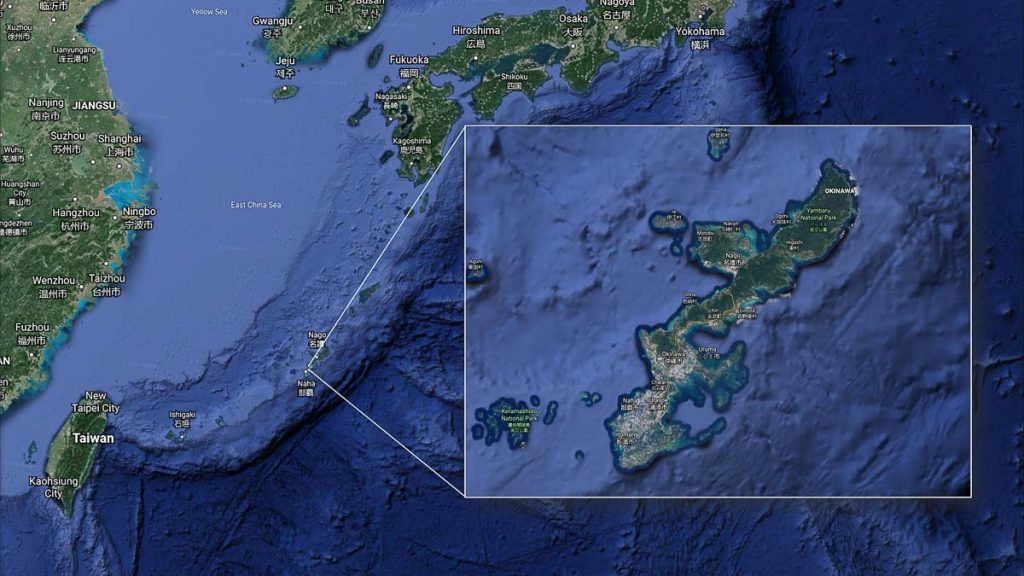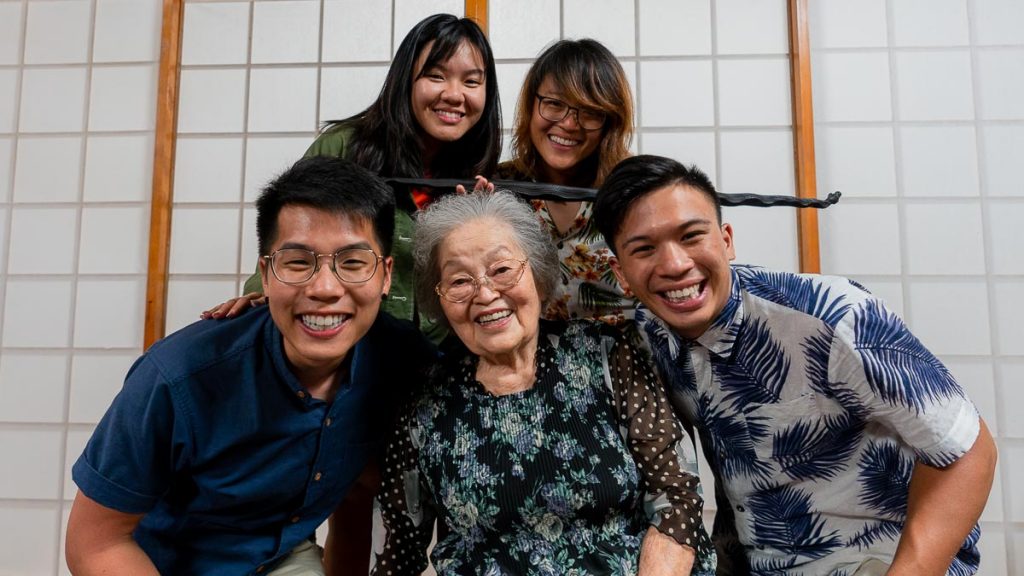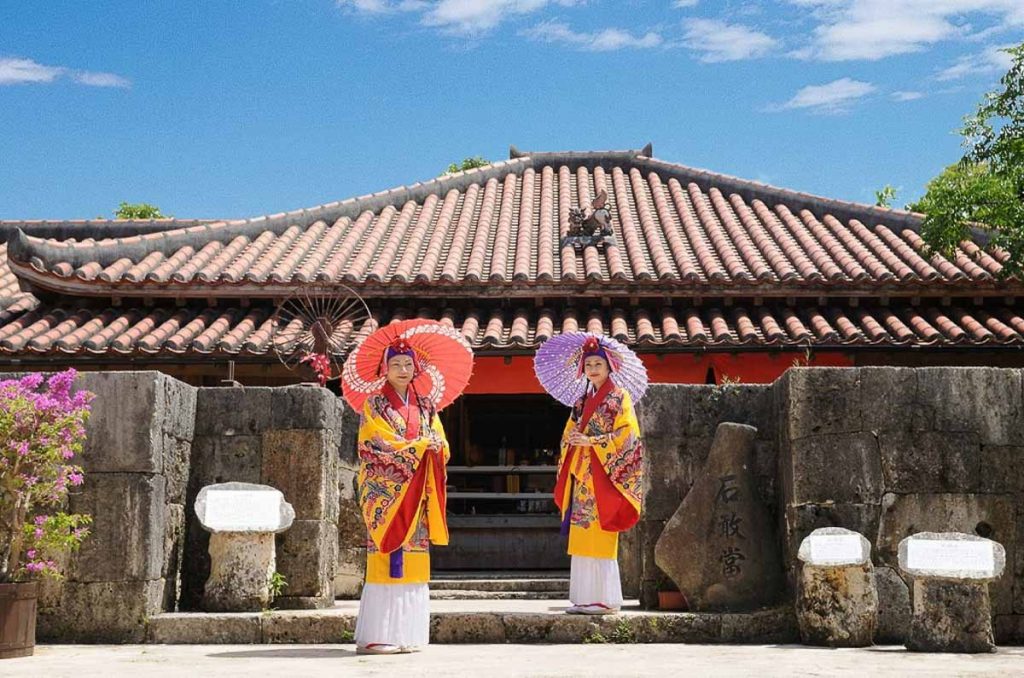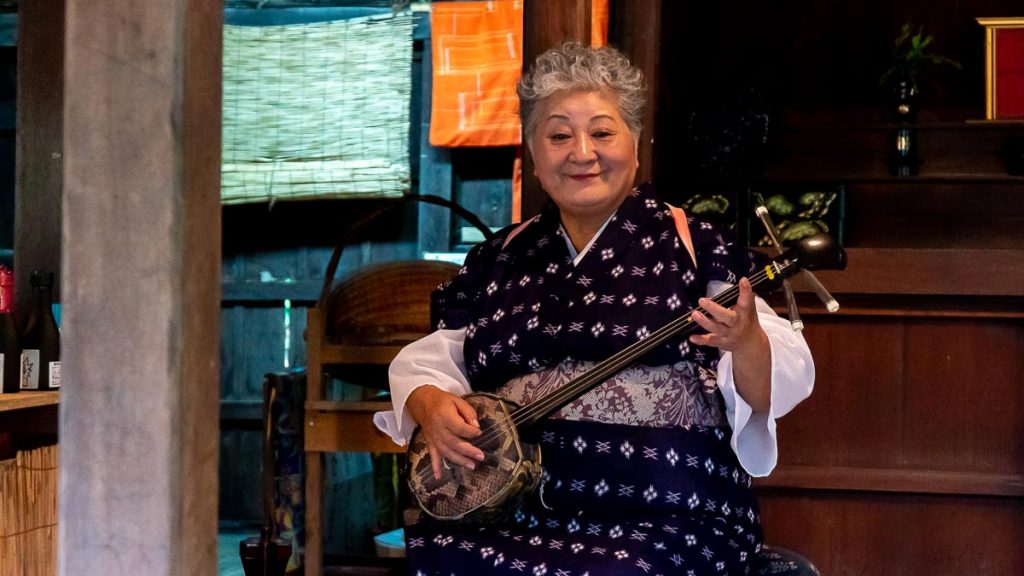One can say Okinawa is more similar to Taiwan than Japan, after all, the distance between Okinawa and Tokyo is 1,554km but only half the distance to Taiwan (731km).
Japan as a travel destination needs no introduction. Places like Tokyo, Osaka, Kyoto, Nara, and Hokkaido reign top tourist destinations year after year. Yet, despite being a well-known country visited for its splendid spring festivals, terrific food, and quirky subcultures, there’s a sunny beach paradise akin to Hawaii that’s been overlooked for a while.
Yes, we’re talking about Okinawa, Japan’s southernmost prefecture that’s significantly different from the rest of Japan.

Here, we dive deep into why Okinawa is so different from the rest of mainland Japan, from culture to architecture and even the food they eat.
Just, where is Okinawa?

Situated in the East China Sea, Okinawa prefecture is a chain of islands located between Kyushu of Japan and Taiwan. Though a part of Japan, it’s not geographically linked to any parts of the rest of Japan — making it the only prefecture that’s not connected on the Japan Rail.
Now you know where it is physically, it’s time to find out more about it.
Okinawa was once its own country

Shuri Castle, the palace of the Ryukyu Kingdom between 1429 and 1879, before it was largely destroyed by a fire in 2019.
Not many know this but Okinawa is the last prefecture to be added to Japan in 1879. Prior to that, Okinawa was part of the Ryukyu Kingdom from 1429 to 1879. Being a kingdom on its own for centuries, Ryukyuans lived almost an entirely enclosed life other than having some trade relations with China back in its heydays.

Katsuren Castle, one of the nine UNESCO World Heritage Sites in Okinawa.
There are still traces of the old Ryukyu Kingdom in Okinawa. Collectively classified as the Gusuku Sites and Related Properties of the Kingdom of Ryukyu, the heritage sites show a glimpse of how the Ryukyu Kingdom was like in the past.

Nakagusuku Castle Ruins
So while mainland Japan is known for its Shinto shrines and torii gates, what you’d really want to see when in Okinawa are the castle ruins and sacred sites, also known as utaki, linked back to the Ryukyuan era.
Read also: Ultimate Okinawa Guide: 33 Exciting Things to Do in Okinawa — Japan’s Paradise Island
Geographical Proximity to other Cultures

Another reason why Okinawa feels so different from the rest of Japan is that it’s pretty far-flung from the mainland of Japan. “Mainland” will be used loosely in this article to refer to the rest of Japan, though it’s good to know that Japan actually has five main islands — Hokkaido, Honshu, Kyushu, Shikoku, and Okinawa.
In fact, Okinawa is a lot closer to Taiwan than to Tokyo of Japan. At the nearest points, Okinawa is about 640 km south of the main island of Kyushu and the rest of Japan while it’s only 500 km north of Taiwan.
It’s hence no surprise that the age-old cultures, practices, and even languages spoken back in the days of the Ryukyu Kingdom are preserved till today due to geographical isolation.
Many people of Okinawa still see themselves ethnically separate from mainland Japanese, with their own culture passed down through generations.
Okinawa’s geographical proximity to other countries like Taiwan, China, and even The Philippines contributes to part of its cultural differences from mainland Japan, and it’s evident in the types of food as Okinawan cuisine bears notable influences from Taiwan. More about that in a bit!
Presence of American Military

Photo credit: Trip.com
Okinawa today is not only shaped by its rich Ryukyuan history or influences from neighboring Chinese states but also an unexpected guest: The USA military. After WWII, the USA promised to defend Japan and set up military bases in Okinawa. The American military brought along their culture and food, creating a uniquely westernised Okinawa.

American Village of Okinawa is a large entertainment complex located near the military bases.
Central Okinawa is perhaps where you’ll see the most American influences, there’s even an entire entertainment complex modelled after America, called the American Village.

In there, you’ll be able to find American fast-food chains such as A&W as well as thrift shops selling vintage items such as old military patches or modified military uniforms.

There’s also some uniquely American-Okinawan food that can only be found in Okinawa. Take the Blue Seal ice cream, for example, it’s specially created for the American soldiers stationed in Okinawa to give them a familiar taste of home. Its slogan? “Born in America, Raised in Okinawa.”

Another distinctively American food you’ll find a lot in Okinawa is luncheon meat, or Spam, as they call it.

Okinawans love their onigiris with Spam, that they’ve modified them to be rectangular — the shape of spam slices cut right out of the tin can, instead of the usual triangular onigiris we’re used to seeing in mainland Japan.
Locals’ way of life

When you think of the tropics way of life, you’re most probably imagining the sun, the sea, the sand, and a relaxed way of life. You’re right, that’s exactly what Okinawa is. A slower and more relaxed pace to life is probably the formula to a long life.

Okinawan locals have an average lifespan of 87, making them one of the four “blue zones” in the world, a term for places where the inhabitants live longer. Not sure about you, but I sure know where I’ll be after retirement.
How different is Okinawa from the rest of Japan?
Traditional costumes: Kimono vs. Ryuso

She is wearing a kimono.

They are wearing Okinawan ryuso. Photo credit: Okinawa World
At first glance, the traditional costume of Okinawa may look similar to the kimono, but if you’re familiar with either of them, their differences are quite telling.
The ryuso is based on Okinawa’s bingata motif, a dyeing method using vivid colours such as red, orange, and yellow. And unlike the kimono, the sleeves of ryuso have big openings to allow for better air circulation for the comfort of wearers in sunny and humid Okinawa. As compared to a traditional kimono that’s fitted snuggly, a ryuso is a loose-fitting garment that’s lightweight and mobile.

Photo credit: Yerba Buena Gardens Festival
Another part of the Okinawan traditional costume is the iconic hanagasa, a large headdress worn by women performing the traditional yotsudake dance. The hanagasa hat represents a large red flower, with the blues symbolising the sky and the silver waves symbolising the ocean of Okinawa.
The language

The performer on the left (in purple ryuso) holds up a banner that reads “men soo ree”, which means “welcome” in Uchinaguchi.
Sure, you can use “kon’nichiwa” when greeting the locals in Okinawa but you’ll probably be given a warmer welcome when you say “hai”. Locals in Okinawa speak a different language from the standard Japanese spoken in mainland Japan. The language is known as Uchinaguchi and is spoken by older Okinawans while younger Okinawans speak Japanese.
Though it’s classified as a “dialect” of the Japanese language by the government of Japan, linguists consider the Unchiaguchi as a language on its own as they have its own set of vocabulary. Below are some examples of vocab differences in Japanese and Uchinaaguchi (Okinawan language).
| English | Japanese | Uchinaaguchi |
| Welcome | ようこそ (yokoso) | めんそーれー (mensooree) |
| Hello (Greeting) | 今日は (konnichiwa) | はいさい (haisai) for male speakers はいたい (haitai) for female speakers |
| Thank you | ありがとうございます (arigato gozaimasu) | 御拝でーびーる (nifee deebiiru) |
| Sorry | ごめんなさい! (gomen nasai) | 悪さいびーん (wassaibiin) |
| Cheers! (when drinking) | 乾杯 (kanpai) | 嘉例 (karii) |
Food

The differences between Okinawa and Japan don’t just stop at dressing and language. One very obvious difference is the food. Don’t expect to get typical Japanese food like sushi/sashimi, tempura, yakitori, gyoza, or mochi easily in Okinawan restaurants. Instead, you’ll find that Okinawan cuisine (or Ryukyuan cuisine) incorporates a lot more pork, sweet potato, and also soybean products.

In Okinawa, it’s impossible to miss the Okinawan soba, which is nothing like the soba you find on mainland Japan. Made using wheat flour instead of buckwheat, Okinawa soba noodles are somewhat like a mix of ramen and udon, yellow in colour and chewy in texture. Okinawan soba is also served in pork broth with either well-simmered boneless pork ribs or pork belly.

Awamori is an alcoholic beverage unique to Okinawa.
Other food differences in Okinawa include drinking sanpin-cha (Jasmine tea) instead of matcha, and the locals’ love for awamori, a hard liqueur distilled from long-grained rice instead of sake that’s brewed using fermented short-grain rice.
Awamori has an alcohol content of 30–43%, higher than sake that’s usually around 18–20%, hence its drank mixed with cold or warm water or even soda.
Read more: Okinawa Food Guide — From the Unusual to the Unapologetically Delicious
Music

If you’ve lived through the nineties to early 2000s, you’ll remember just how big J-pop was a thing. Teens were listening to Namie, Ayumi, SMAP, Arashi, etc… J-pop may have lost its appeal to K-pop in the recent decade, but it’s still no doubt what the Japanese listen to most.
Fun fact: Some of the biggest J-pop artists such as Namie Amuro, GACKT, Kiroro, Speed (band), DA PUMP (band), and MAX (band) are homegrown Okinawans
In Okinawa, though, a very different music genre can be heard throughout the island. Ryukyuan music, or also known as Nantou music is Okinawan folk songs are what you’ll hear in shops or restaurants or performed in public areas by musicians. They are generally accompanied by the sanshin, a three-stringed banjo-like musical instrument, and various taiko drums.

Today, new genres of music can be heard in Okinawa. New folk songs with contemporary pop music arrangements sometimes referred to as shima-uta, as well as Uchinaa pop — Okinawan folk music with blended with American rock music influences are popular in Okinawa and mainland Japan.
Sure, Okinawa is vastly different from mainland Japan — you won’t be able to find gorgeous hanami spots, high-speed rails, or even Instagrammable shinto shrines. But there are plenty of dramatic landscapes, culturally-rich heritage sites, and amazing seaside activities that Okinawa has to offer, and that’s just how it stands out.

This article is part of a new series where we uncover and honour the cultural differences of communities all over the world. What other cultures would you like to know more about? Let us know in the comments below.















To say that Okinawa is close to Taiwan is an insult to the Okinawan. Conservative clans identify themselves as Ryukyuan not Okinawan.
Hi Carmen, thanks for your comment, we really appreciate you sharing your knowledge of Okinawa with us:) To clarify though, the article meant “closeness” in terms of geographical distance, and what we see of Okinawa today is largely due to influences from regional cultures, including that of Taiwan. Of course, Okinawa’s vibrant and rich history goes way back, which we hope we mentioned in simpler terms for the majority of readers to understand and get a gist of. If we could improve in any other ways, do let us know! Thank you!:)
The differences between Standard Japanese and Uchinaaguchi are no bigger than what you can find between standard Japanese and other dialects.
Thanks for your comment, Markus! By “differences” do you mean grammar, phonetics, conjugation, vocabulary..? and what would the similarities shared by Standard Japanese and Uchinaaguchi, as well as the other dialects of Japanese, be? I’d love to learn more! 🙂
Do correct me if I’m wrong too (I’m not Japanese nor speak Japanese or Uchinaaguchi) — based on my research of the Japonic linguistics, Uchinaaguchi (as well as the other Ryukyuan languages)—not to be confused with Okinawan Japanese—is not mutually intelligible with Standard Japanese, hence is considered to be a separate language. Though we cannot rule out the fact that the classification of languages and dialects is often arbitrary and grounded in sociopolitical motives. I’d love to go deeper into the linguistics discussion for this article but that would definitely bore a majority of the readers, LOL! 🙂
Okinawa people are seriously so much nicer then tokyo people haha, I’m more happy in my 5 day stay here then my 2 years living in tokyo. Will definitely move over one day!
The charms of a relaxing lifestyle! I’d move to Okinawa if I had a chance to too! 🙂
Hi, when you mentioned J-POP, you should’ve delve deeper into Okinawans like Namie Amuro, The Pump, Speed, Max, n other homegrown artists who ruled the charts into 2000.
Needless to say Ultraman’s author (Kinjo) was Okinawan.
All that said, I loved your article and shared it on my Facebook page.
I love Okinawa n very proud to be a “Shimagaijin”.
Hey J.B., thanks for your comment! Indeed, homegrown Okinawan singers deserve a mention, and I’ll be sure to update the article 🙂
Kind words like yours really keep us going, appreciate it! Cheers!
I currently reside in Okinawa and this article really helps me to understand the Okinawa way of life. The first time I said Haisai instead of Konichiwa made a woman’s eyes light up!
That’s amazing to hear, Amanda. Thanks for sharing! Hope all’s well over at Okinawa 🙂
Could you tell me about ,principal religion of the habitants okinawans..
And which are this believes.
Thanks…I am very interest
Hi Eduardo! Thanks for your interest in Okinawa 🙂 Based on research, the Okinawans practice Ryukyuan religion or Ryūkyū Shintō, an indigenous belief system of the Ryukyu Islands. Over time though, there have been influences from Japanese Shinto, Chinese religions, Christianity, and Buddhism, etc.
You did an outstanding job with your article. I lived in Okinawa for five years, and married a beautiful pride from there almost 22 years ago. She still has the same traditions and loves her family and friends that still live there. The next time you cover this topic there are a few national living treasures that stay in Okinawa, the glass factory, the caves, and some of the many islands that surround the beautiful place. Nice work.
Thank you, L. Cal! We’re glad you enjoyed this piece! You’re right, there’s still so much more of Okinawa that we’ve yet to cover, especially the islands. We’d love to revisit Okinawa again someday and we hope that the lovely folks are keeping safe now. Cheers and take care too! 🙂
“Many people of Okinawa still see themselves ethnically separate from mainland Japanese.”
This is because Ryukuans ARE the indigenous peoples of this land, recognized by the UN as such (although not recognized by the Japanese government yet). We have endured double efforts to erase our culture by colonizers (Japan, US, then Japan again).
That is why.
despacito
Lived in Kadena from 63-66. Would love to go back to see it but the plane ride would be too much for me now! My AF husband was on the Kadena Golf Team. A wonderful extended honeymoon except for the water bugs!
1
<3 your article! My mom has performed in a traditional Okinawan dance group for decades. It's wonderful to see the traditions continue, as I have worried about the Okinawan language & culture being lost over time. Thank you so much for putting a spotlight on Okinawa for the world to see!